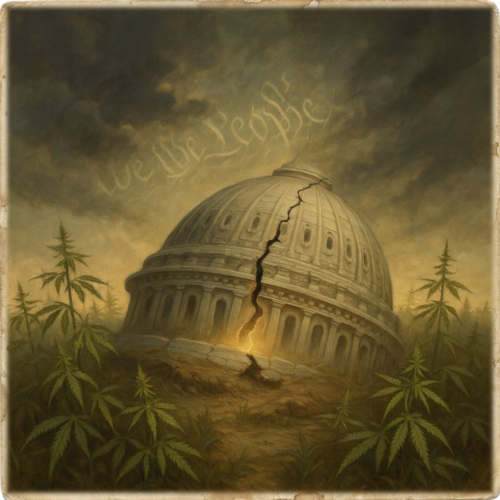South Dakota’s cannabis legalization campaign reveals a complex battle between industry influence aiming for market expansion and local opposition focused on community values and public health.
As South Dakota prepares for the November 5 vote on Initiated Measure 29—a ballot initiative that would legalize adult-use cannabis—the campaign has turned into a high-stakes battleground of financial influence. If approved, the measure would allow adults 21 and older to possess, use, and distribute up to two ounces of marijuana. With substantial funding on both sides, the effort reflects a complex intersection of social, financial, and strategic motivations. Industry backing, in particular, hints at ambitions that go beyond legalization itself, with potential implications for shaping the market’s future.
Major Contributions from the Cannabis Industry Powering Legalization
South Dakota’s cannabis legalization effort has seen significant financial support from the industry itself, suggesting a vested interest in guiding the formation of a new market. The Yes on 29 Ballot Committee, which leads the charge for legalization, has raised around $458,000, nearly $300,000 of which comes from cannabis businesses. Notably, GL Partners Inc., a medical marijuana dispensary in Rapid City, made the single largest contribution at $100,000, reflecting the industry’s robust involvement. This influx of industry funding could indicate an intention to steer the regulatory landscape in a way that aligns with familiar frameworks from other legalized states, potentially smoothing a path for future expansion.
Some might suggest that the industry’s investment is not purely in favor of legalization but also part of a larger strategy to shape the market in ways that benefit existing players. If Measure 29 passes, it could allow for the development of social equity programs that open doors for licensees, some of whom might be courted by larger industry players. This approach—seen in other states—could enable the industry to cultivate relationships with local licensees, potentially laying the groundwork for future mergers or acquisitions. Thus, while the immediate goal is legalization, the longer-term vision may involve influencing market dynamics to create a more predictable, industry-friendly environment.
Opposition Funding: Local Donors and Community Concerns
On the other side, the Protecting SD Kids Ballot Question Committee has raised a comparable $457,000, primarily from local contributors who view legalization through a more cautious lens. Local business owners and residents comprise much of the opposition’s funding base, including a significant $61,400 donation from Brad Wheeler, a local manufacturer. The opposition argues that Measure 29 poses risks to public health and safety, particularly concerning youth access. Their campaign emphasizes the need to protect community standards and suggests that legalization could compromise these values by introducing a potential for increased substance exposure.
This local funding underscores a grassroots effort to counterbalance industry influence, rallying those who may view cannabis legalization as a gamble that South Dakota should avoid. The balanced financial contributions on both sides reflect a community deeply divided on the issue, with both camps vying to sway voters by spotlighting either the benefits or potential risks of legalization.
Balanced Funding, Divergent Strategies
The financial parity between the two sides sets up a balanced yet strategically contrasting battle. While both campaigns have raised similar amounts, their priorities differ starkly. The Yes on 29 committee has channeled approximately $217,000 toward advocacy efforts, while the opposition has spent $371,000, primarily on messaging that emphasizes the social risks of legalization.
The strategic underpinnings of these efforts reveal divergent priorities. For the cannabis industry, this may be more than a single campaign; it could be a blueprint for establishing a market framework conducive to scaling and expansion. If successful, the campaign could replicate approaches seen in other states, allowing cannabis businesses to form strategic partnerships with local license holders, potentially with an eye toward eventual acquisitions. For the opposition, the aim is clear: protect South Dakota’s community standards from what they view as unnecessary risk.
Broader Implications: A Template for Future Legislation?
Should Measure 29 pass, its impact might extend beyond South Dakota, potentially influencing neighboring states with similar considerations. The cannabis industry’s participation suggests a potential interest in establishing a legislative template that could be applied across other emerging markets, streamlining the entry process and minimizing regulatory hurdles. With standardization in mind, industry advocates may be looking to pave a more straightforward path for regulatory compliance and partnerships in states with nascent cannabis markets. A successful outcome here could set a precedent for similar measures in conservative regions, gradually expanding the national legalization landscape.
Conversely, if Measure 29 fails, it may serve as a cautionary tale for other states with strong community-rooted opposition to cannabis. The industry’s ambitions, however strategic, may not outweigh local priorities and concerns over social impacts, underscoring the difficulty of establishing industry-friendly legislation in more conservative areas. For South Dakota, this decision will signal whether the state is ready to embrace the cannabis industry or if it will hold firm on its current stance.
The Stakes of South Dakota’s Decision
As the November vote nears, South Dakota’s campaign for marijuana legalization has become a financial tug-of-war reflecting broader societal and economic debates. Industry contributions hint at a possible intent to replicate successful strategies from other states, building a market structure that could facilitate expansion and even acquisition opportunities. Meanwhile, local opposition voices community concerns and prioritizes public health over economic gains. In this intricate landscape, South Dakota’s decision on Measure 29 isn’t solely about cannabis—it’s a critical referendum on how much influence the industry may have in crafting future markets.

***
Trap Culture is the ultimate destination for cannabis enthusiasts who want to experience the best of Arizona’s cannabis culture. Whether you are looking for the hottest cannabis-friendly events, the latest news on debunking negative myths about marijuana, trends in the industry and exclusive, limited-edition products from the top brands in the market, Trap Culture has you covered. Visit our website to learn more about our events, our blog, and our store. Follow us on social media to stay updated on the latest news and promotions. Join the Trap Culture family and experience the most immersive and engaging social cannabis events in Arizona.




